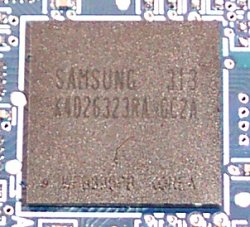Card examination

The G9800 Pro-M is laid out in very similar fashion to the G9600 PRO. Tyan still uses a custom double-sided heatsink that covers both the GPU and RAM together. The fan's cabling is neatly routed to one side. The fan appears to be a replica of the one found on the cheaper G9600 PRO. It's interesting to note that Tyan also produce a strictly reference 9800 PRO, right down to the red PCB and ATi-esque aluminium cooler. This enhanced model, named G9800 PRO-M, provides hardware monitoring and variable fan speed adjustment, with the M denoting monitoring, presumably.

Apart from the cooling itself, the major change from the reference design is the use of a floppy-style power connector. Every other 9800 Pro that we've seen has used a standard MOLEX conduit. Tyan's method allows it to save a little board space. The card itself sits on a PCB that's exactly the same size as the reference model. Our guess would be that the oversized heatsink required the use of a smaller auxillary power connector, much as the one found on the Radeon 9700 PRO. A purely personal feeling here, but FX 5900 / Ultra cards just appear to be more expensive. Whether that's to do with their increased size or sometimes wacky cooling, I don't know. The low profile heatsink and fan ensures that you won't have to sacrifice a PCI slot. However, with the number of features integrated into modern chipsets, even having to lose a single PCI slot, assuming one is placing the card into a normal ATX motherboard, isn't such a big deal.

Here we see the back of the card that houses the double-sided heatsink. It's not hewn from a single piece of aluminium. Rather, it connects together at the very top. You can probably see that the front heatsink overlaps the rear one. Removing it is simply a case of pushing through the plastic spring-loaded pins.

128MB of Samsung's 700MHz-rated TinyBGA DDR-I is present on this card. That's what we've found on each and every 9800 PRO. Triplex was even brave enough to specify it on its enhanced REDai 9600 PRO. Remember that the 128MB 9800 Pro's clock speeds are 380MHz VPU and 680MHz memory. 700MHz memory, therefore, is spot on. The Pro-M looks as if it should offer a little more than basic memory and core speeds. PowerColour have recently launched a 9800 Pro with pre-inflated 400MHz VPU and 760MHz DDR clocks. We'd love it if other manufacturers were prepared to disregards official specifications and go beyond what ATi mandate. From what we can perceive, all that differentiates this particular Tyan 9800 PRO-M from the standard Tyan version is the variable fan speed control and dual-sided heatsink. Call us critical, but we'd expect a little more from a card that's effectively higher up in Tyan's range.

Tyan impressed us by unequivocally stating that the G9600 PRO would be available in a dual DVI format, yet that announcement was shortlived.. It would be nice to have such an impressive card powering two TFT displays through DVI connections. As it is, it's HD15, S-Video and DVI-I on this model. We wait and hope for a dual DVI model.









